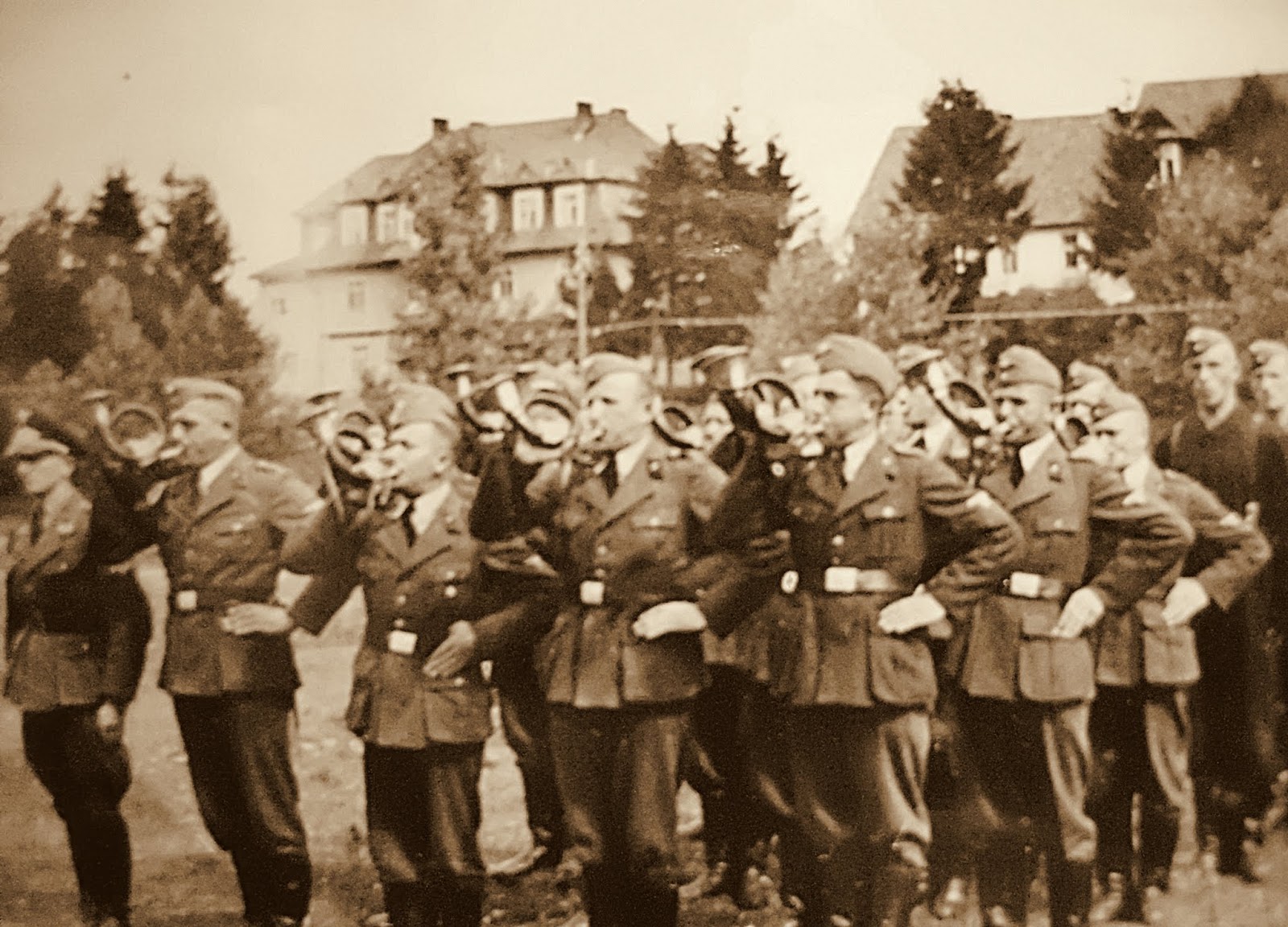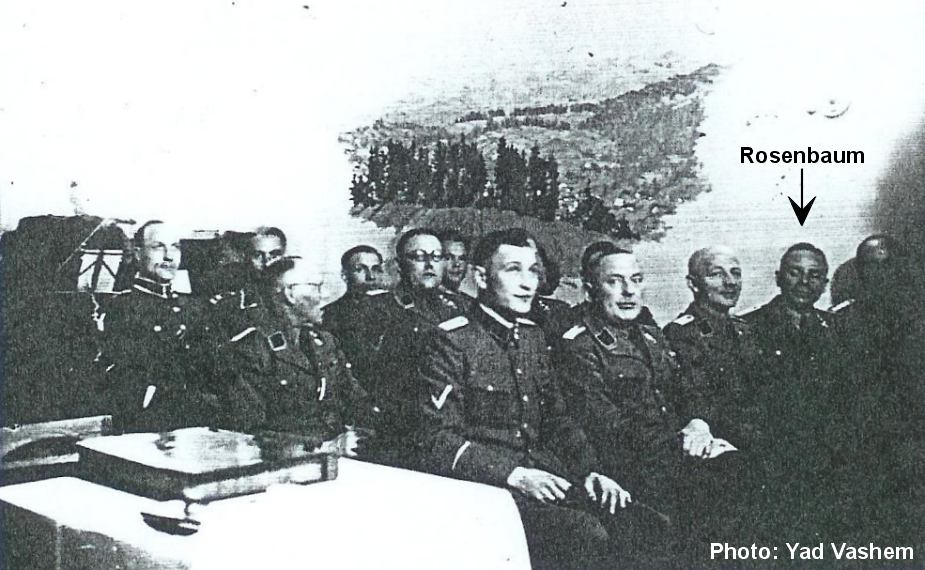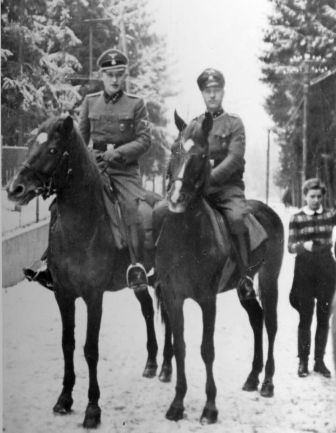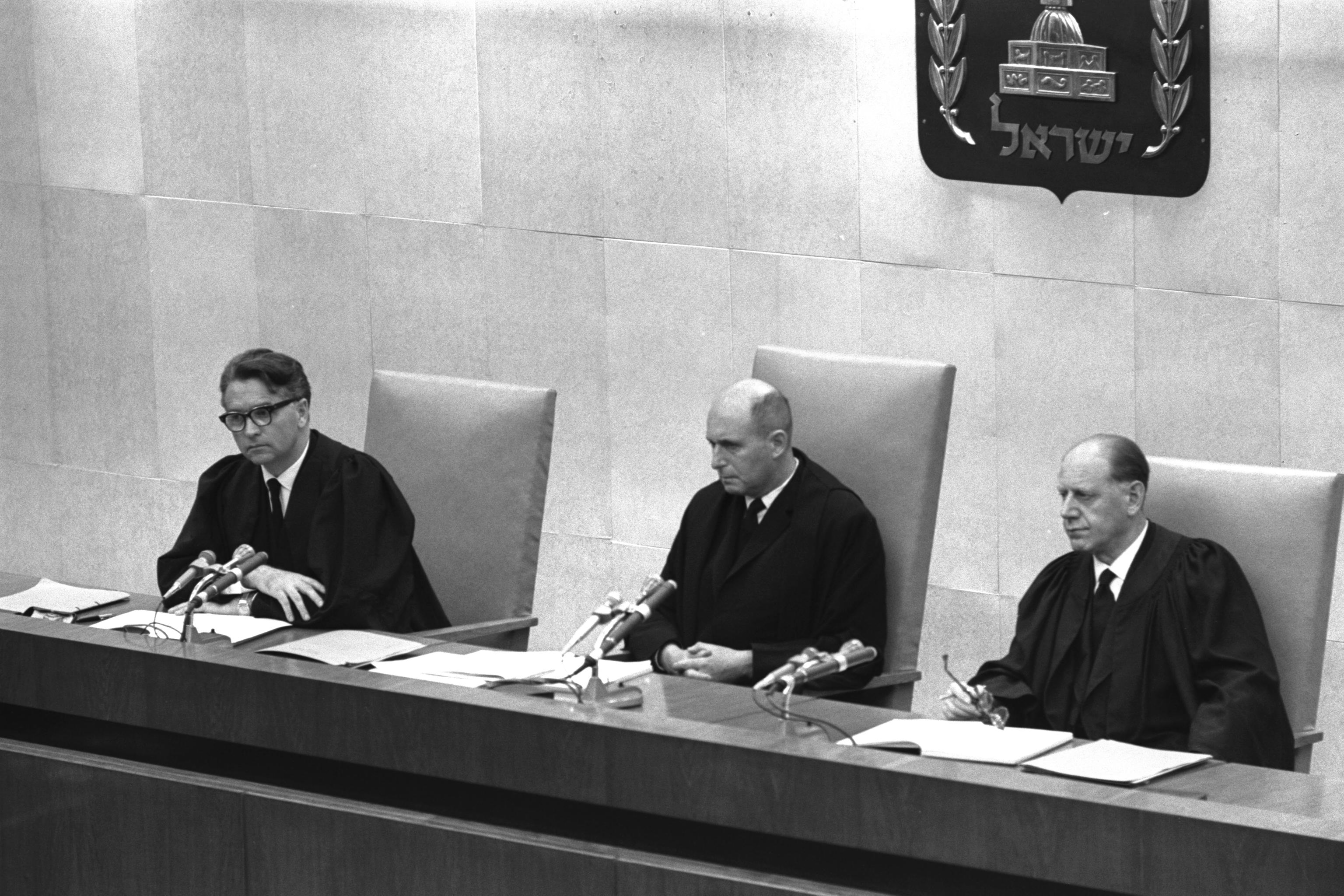Informacja jest cenniejsza jak złoto.

Historia Rabki: Tajemnicze zdjęcia - Forstschutzkommando w Rabce

Mroczne sekrety Willi "TERESKA"
http://en.calameo.com/read/0004616407c97116451a2
Proszę obejrzeć historię Rabki w okresie okupacji niemieckiej.
Szkoła policji w Rabce

Historia Rabki: „Pedagodzy” z Kriminalpolizei*
historiarabki.blogspot.com320 × 220Search by image
od lewej: Ukrainiec Zenon Jaworski, SS-Scharführer Alfred Schulz, NN, SS-Untersturmführer Wilhelm Rosenbaum
Vater Alfred Schulz ?

bigrabka14.jpg
www.deathcamps.org925 × 570Search by image
... and deputy to the commandant, SS-Hauptsturmführer Hans Krüger. Rosenbaum's duties were more of a matronly nature, arranging board and lodging, salaries, ...


Wilhelm Rosenbaum http://www.HolocaustResearchProject.org
www.holocaustresearchproject.org336 × 433Search by image
Wilhelm Rosenbaum (left) at Bad Rabka
Fortschutz posiadał własną orkiestrę. „Idziemy do Polski, do kraju nieznanego, by zabezpieczyć w nim pracę, honor i prawo” – brzmiały słowa ich hymnu.
Mroczne sekrety Willi "TERESKA"
...
Zobacz więcej
DOZWOLONE DLA OSÓB KTÓRE UKOŃCZYŁY 18 LAT !
Otwórz LINK na własną odpowiedzialność
Szkoła Morderców !!! SS i SD w Rabce
http://www.jewishgen.org/yizkor/Galicia2/Galicia2.html
Rabka Police School
(Poland)
Click here to see how to add a Memorial Plaque to this Yizkor Book
Acknowledgments
Written and contributed by:
Robin O'Neil
Salisbury, England - 17th February 2004
This material is made available by JewishGen, Inc. and the Yizkor Book Project for the purpose of
fulfilling our mission of disseminating information about the Holocaust and destroyed Jewish communities.
This material may not be copied, sold or bartered without JewishGen, Inc.'s permission. Rights may be reserved by the copyright holder.
JewishGen, Inc. makes no representations regarding the accuracy of the translation. The reader may wish to refer to the original material for verification.
JewishGen is not responsible for inaccuracies or omissions in the original work and cannot rewrite or edit the text to correct inaccuracies and/or omissions.
Our mission is to produce a translation of the original work and we cannot verify the accuracy of statements or alter facts cited.

Biography of the Author
The Author: Honorary
Research Fellow UCL,
Salisbury UK Robin O'Neil
Dr. Robin O'Neil is a former police major crimes investigator who worked at the cutting edge of major criminal investigations in the United Kingdom and Central Europe. Formerly of Scotland Yard, the Metropolitan and Home Counties Police. service, he then took up the challenge of academia. After obtaining his Master’s and Doctorate with University College London, he now specializes in the investigation of Nazi war crimes and the destruction of the European Jewish communities 1933-1945. He is a regular lecturer at Universities in the United Kingdom, United States, Israel and Eastern Europe
|
Sanok komendant Gestapo - Albert Schulz
http://kehilalinks.jewishgen.org/sanok/
Source: http://www.ghwk.de/engl/catalog/cateng3.htm
_________________________
Dr. Werner’s book describes his childhood in Sanok, escape from the Sanok ghetto and how he managed to survive the war. This book was originally written in Hebrew in 1999 and is titled "Revach Vehazala Mimakom Acher".
(Dr. Werner’s book can be read online by clicking on its title. You may contact Dr. Werner by clicking on his name.)
_________________________
 Judenrat Correspondence
Judenrat Correspondence
World War II Correspondence
Courtesy of Dr. Abraham Werner / Translated by William Leibner
(Dr. Werner is the son of the author of the letters below & received permission from the Polish Jewish Historical Archives to publish these documents.)
The document below was provided by Dr. Avraham Werner and loosely translated from Polish by William Leibner. It appears to be a copy of a report sent by the local Sanok J.S.S. (Jewish Self Help Organization) branch to its headquarters in Krakow. The J.S.S. helped various Jewish communities during the initial stages of World War II.
_________________________
Place - Sanok District - Sanok Region - Krakow
Postal area - Sanok, 9 Galicia, Poland
“Sprawozdanie” (Fact Report)
From September 1st 1941 to September 31st 1941
_________________________
My War Years by L.T.
(excerpt from Memorial Book of Zaglembie describing an escape from Zaglembie and contact with the town of Sanok)
On the train all the four of us – my two cousins, my friend and I – stayed silent for the most of the journey. Each was thinking her own sad thoughts, but after some time we regained our confidence and our hopes grew brighter with every past mile. We were planning to get over to the Russian side and then to help our families do the same. The train stopped at Tarnow. We slept there in the abandoned farmhouse of "Ha'noar Hazioni". The whole town looked a dead town. Not a single Jew could be seen in the streets. We reached Sanok by various side-ways and paths on the 1st of November. Sanok was situated on the river San, which formed the Russian-German border. Most of the local Jews had escaped to the Russian side, but there was still active there, a special help-committee for the refugees. At that Committee we got same food and a place to sleep. We intended to wait there for the border to be opened, but after three days of useless waiting we decided to smuggle the border on our own. In the dark and cold of the night, wearing heavy clothes and carrying our rucksacks on our backs, we stepped into the deep, cold waters of San, following a Ukrainian smuggler. Suddenly the Ukrainian disappeared, and we, four frightened girls, heard the first Russian: "stoi, kto idiot ?" In front of us stood three Russian soldiers with threatening guns. We exclaimed happily: "My Yevrei !" But the soldiers laughed and told us to follow them. Page 49
_________________________
Gypsies in the Holocaust - Gypsies from the General Government [Poland] who were not sent to Auschwitz and to the operation Reinhard camps were shot on spot by the local police or gendarmes. In the eastern region of the Cracow district, in the counties of Sanok, Jaslo, and Rzeszow, close to 1,000 Gypsies were shot..."
Source: http://www.jewishvirtuallibrary.org/jsource/Holocaust/gypsies.html
_________________________
Polish Rightous Among Nations –“Those who Risked their Lives”
PYRCAK, Michal, living at Sanok, Krosno province - arrested for his part in helping Jews, sent to the camp at Mauthausen, from where he never returned. Posthumously awarded the medal of "Righteous Among the Nations". Source: http://www.savingjews.org/perished/p.htm
_________________________
· 3,000 in Rebel Band Terrorize Galicia (NYTimes – April 18, 1946)
· Sanok, Poland, September 1939, German Soldiers Guarding Jews (photo)
· Claims Resolution Tribunal - Klara Ramer, Salomon Ramer and Samuel Herzig
· Personal Receipts, Postcards

Excerpt from the testimony of Yakov Gurfein (photo, 1961)
One morning, in the middle of January 1943, they woke us up. We saw that we were surrounded by SS men who were stationed around the ghetto. They ordered us to line up in the courtyard, allowed each one to take a blanket, and led us on foot to the Zaslaw camp (from Sanok ghetto). At Zaslawthey put everyone into one hall and kept us there for three days and two nights.
(to read more of this account, go to: http://www.deathcamps.org/belzec/belzecjumpers.html )
Transcript from Session-021-03 – People vs. Adolf Eichmann
http://www.nizkor.org/ftp.cgi/people/e/eichmann.adolf/transcripts/ftp.py?people/e/eichmann.adolf/transcripts/Sessions/Session-021-03
Judge Halevi: Mr. Gurfein, you mentioned the members of the
SS - Kratzmann, Mueller and Schulz.
Witness Gurfein: Schulz was the commander of the Gestapo in
Sanok.
Q. And who was Kratzmann?
A. Kratzmann was the Judenreferent within the Gestapo.
Q. Where was his office?
A. In the Gestapo of Sanok.
Q. And Mueller?
A. He was also a Gestapo man in Sanok.
Q. I didn't understand what you said about them. How did
they take part in these events?
A. Kratzmann and Mueller were the most terrible Gestapo men.
They also took part in the killing of Jews. The officer
Schulz reached us in 1942 from Yaroslav. Subsequently we
realized that he had come especially to organize the
deportation of the Jews of Sanok. As I mentioned, they came
to us, for we were a number of Jews together with their
families within the camp of the Schutzpolizei (Civil
Police). We hoped that we would be able to remain and to
work there. They arrived that night, and saw that not all
the people were capable of working. There were also small
children. Despite the fact that previously they had allowed
us to come into that camp with the members of our families
as well, they separated us from each other and left only 20
persons.
Presiding Judge: You were asked what was the role of each of
these Gestapo men.
Judge Halevi: What did the three Gestapo men, whose names
you mentioned, do?
Witness Gurfein: At that time they separated our families
from us, they loaded them onto trucks and transferred them
to the Zaslav camp to be deported.
Q. You stayed there?
A. We remained in the camp of the Schutzpolizei.
Q. What happened to your families?
A. They removed them to the camp at Belzec in that same
train, except for my uncle whom they gave another three
months to live, and he was shot at the time the 500 people
were shot.
Q. You said something about 10,000 Jews. Were they sent away
all at the same time?
A. They were sent away together in three trains.
Q. Where to?
A. To Belzec.
Q. Was a separation made between those fit to work and
others?
A. They took all the 10,000 Jews, both those who were fit to
work, and also women, children and old men.
Attorney General: The camp at Belzec was an extermination
camp, not a labour camp. There they did not separate people.
There they exterminated everyone who arrived at the place.
Judge Halevi: You spoke of a particular case of separation
of the families and that they cheated you and told you that
within a short time you would see your families again?
Witness Gurfein: This was on that night, before the
deportation, when they took the parents and the children
away from us. The people who still remained in the camp
began to plead that they should leave the families behind as
they had promised. They calmed them down by saying that this
was nothing, they were taking them only to some new
habitation - we would be reunited within a week.
Q. Who said this?
A. The Gestapo commander in Sanok, Albert Schulz.
Q. That was a lie?
A. Of course, seeing that on the following day they
transferred them by train to an extermination camp.
Judge Raveh: Did you meet any other persons from your town
after the War?
Witness Gurfein: Yes. I met people. There were those who hid
and who were not included in this transport. They hid with
Christians and managed in this way to be saved. But of those
who were on the train, I didn't meet anyone.
Q. Do you have an idea how many Jews of your town were
saved?
A. I think that it would be possible to count them on the
fingers of one hand - five or six people.
Q. Out of a population of 13,000?
A. Yes.
Q. Did your uncle survive?
A. No. They took him on the second transport and he perished.
_________________________
JewishGen Holocaust Database
_________________________
The Central Database of Shoah Victims' Names
**Yad Vashem**
http://www.nizkor.org/ftp.cgi/people/e/eichmann.adolf/transcripts/ftp.py?people/e/eichmann.adolf/transcripts/Sessions/Session-021-03
LINK dla badaczy:
The Gestapo commander in Sanok, Albert Schulz
https://www.pinterest.com/pin/437764026250658176/
http://www.deathcamps.org/treblinka/perpetrators.html
http://www.deathcamps.org/sobibor/perpetrators.html
http://en.calameo.com/read/0004616407c97116451a2
http://www.deathcamps.org/reinhard/rabka.html
http://www.jewishgen.org/yizkor/Galicia2/Galicia2.html
http://kehilalinks.jewishgen.org/sanok/
http://www.nizkor.org/ftp.cgi/people/e/eichmann.adolf/transcripts/ftp.py?people/e/eichmann.adolf/transcripts/Sessions/Session-021-03

Zakorzeniony w historii Polski i Kresów Wschodnich. Przyjaciel ludzi, zwierząt i przyrody. Wiara i miłość do Boga i Człowieka. Autorytet Jan Paweł II
Nowości od blogera
Inne tematy w dziale Polityka

